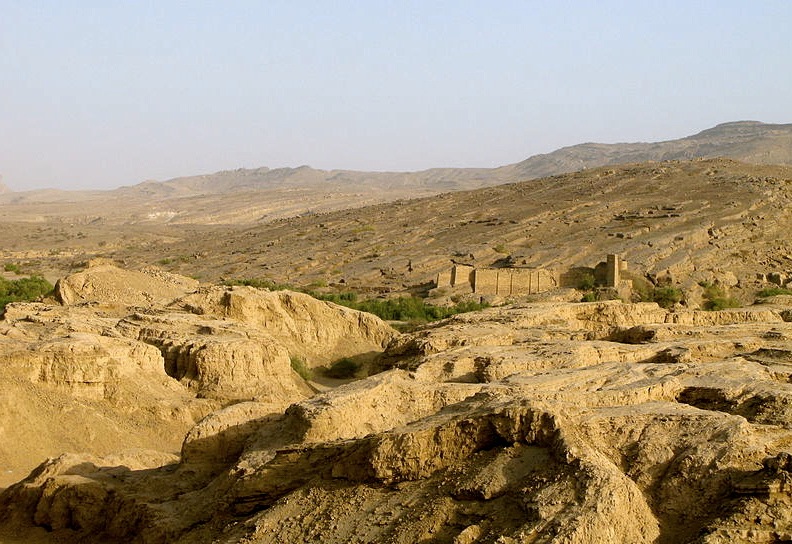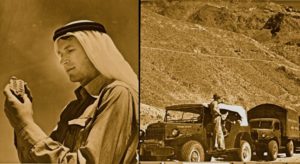
And when the queen of Sheba heard of the fame of Solomon concerning the name of the Lord, she came to prove him with hard questions. And she came to Jerusalem with a very great train, with camels that bare spices, and very much gold, and precious stones……….1 Kings 10:1,2
Western Yemen, 1951—Approaching the village in their big Dodge Power Wagon, it didn’t take long before Wendell Phillips and his small party of explorers became surrounded by a mob of rifle-armed tribesmen and soldiers. Dressed in blue robes and faces painted in indigo, the mob stood transfixed, staring at them in silence. Clearly outnumbered, Phillips knew that one knee-jerk move among his crew could spark gunfire. These locals had never seen Europeans or motor vehicles. Phillips and his group were traveling in what for Westerners was unexplored land—the forbidden regions of Yemen.
But Phillips had the blessings of Imam Ahmed, the King of Yemen, and it wasn’t long before Arabian friends with some clout and familiarity showed up to save them from what could have been a disastrous end to this expedition. Phillips, a paleontologist and geologist by education and an explorer by chosen occupation, was leading this expeditionary group to an ancient site he had long dreamed of excavating—a site that, until now, had been off limits for decades to anyone from the West. It was the location of Marib, the capital of the ancient kingdom of Sheba, thought to be the seat of the famous tenth century B.C. biblical queen of Sheba and a center made rich in the centuries BC by the lucrative revenues and trade of the Incense Road. Soon a much larger team of specialists would follow with a convoy of trucks bearing equipment, supplies, and an eclectic crew of archaeologists, photographers, epigraphers, physicians, and others. William F. Albright, by this time already world-famous for his archaeological discoveries and scholarship related to the lands and cities of the Bible, would be his chief archaeologist for the dig.
Arguably considered today as a real-life model for the famous fictional character of Indiana Jones, Phillips had already cut his teeth in a significant way in the late 1940’s as leader of a major U.C. Berkeley expedition in Africa, taking him from Cairo to Capetown with an entourage of experts in a variety of scientific fields. “In the course of the expedition, more than fifty scholars, scientists, and technicians, utilizing 25 trucks, an airplane, and a motor-boat, had covered the entire continent, working on research problems in tropical medicine, paleontology, geology, anthropology, archaeology, and other fields,” wrote Phillips of his African expedition in his 1955 book, Sheba’s Buried City.* It was also in Africa where he received his inspiration to explore southern Arabia.
“Many things conspired to bring South Arabia into my mind during the African expedition,” he wrote. Significant among his inspirers was the Aga Khan, who “suggested South Arabia as one of the most essential remaining areas for archaeological work.”*
Phillips wasted no time moving forward to Arabia. Following his African expedition, he embarked on a two-week aerial reconnaissance survey expedition of southern Arabia in 1949.
It hooked him.
“I saw beneath the shifting sand dunes, the parched wadis, and tumbled rocks, a long highway stretching 700 miles across the broad base of the country, then turning northwards and winding for more than 1,000 miles to the shores of the Mediterranean and the homes of our civilization’s ancestors. I looked back over my shoulder 3,000 years and saw long trains of camels burdened with frankincense and myrrh and sometimes with gold, pearls, ivory, cinnamon, silks, tortoiseshell, and lapis lazuli.”*
Phillips was writing of course about the great Arabian Incense Road of antiquity, the road that presumably, at least in part, made rulers like the Queen of Sheba, and ostensibly by extension her royal friend and ally King Solomon to the north, wealthy beyond imagination. The Road was the maker of a number of southern Arabian kingdoms, most notably the five kingdoms of Qataban, Ma’in, Saba (Sheba), Himyar, and Hadhramaut. Of these kingdoms, Saba, as it was the kingdom of the queen of Sheba, fed Phillips’ ambitions the most. But in the 1940’s, the ancient capital of Saba, whose remains were located at the site of Marib in southwestern Yemen, was in the forbidden zone. It could not be safely accessed by Westerners because of tribal hostilities.
Marib would have to wait. Phillips turned to the other possibilities, consulting with familiar sources for advice. “In Cairo I had lunch with St. John Philby [the British Arabist, explorer, writer, and colonial office intelligence officer ], who………encouraged me and agreed that I should consider the Wadi Beihan, site of the capital of the old Qatabian kingdom.”* Charles Inge, friend and then Director of Antiquities for Britain’s Crown Colony of Aden, recommended it “as the most promising site in all southern Arabia, with the exception of the Queen of Sheba’s ancient capital, Marib and the ruins of Sirwah located in forbidden Yemen.”*
It was thus on to the site of Timna, the ancient capital of Qataban in the Wadi Beihan, for what Phillips called his First Arabian Expedition under the auspices of his newly founded American Foundation for the Study of Man (AFSM), the organizational framework he knew he would need as the umbrella instrument of his efforts. Getting things off the ground was no easy task, but painstaking preparations saw him at the head of a convoy of trucks, equipment and a hand-picked mix of specialists and experts that reflected shades of his previous African expedition.
________________________________
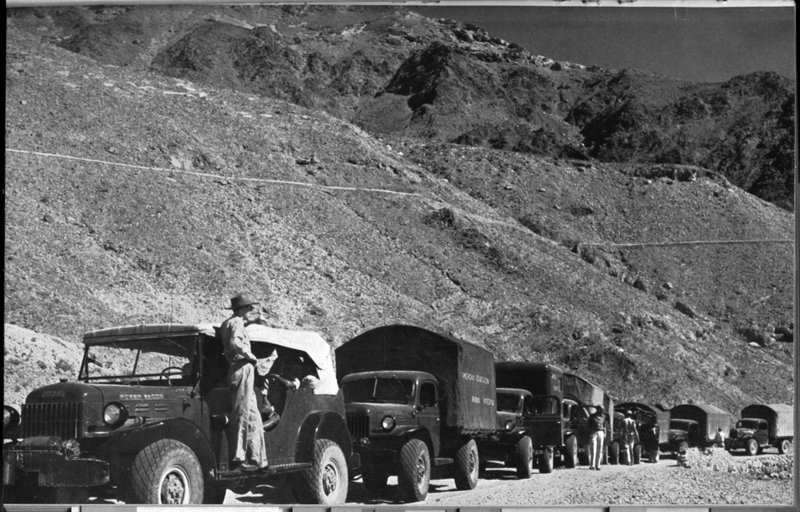 The expedition convoy makes its way through the desert landscape of Yemen. Courtesy American Foundation for the Study of Man (AFSM)
The expedition convoy makes its way through the desert landscape of Yemen. Courtesy American Foundation for the Study of Man (AFSM)
___________________
The Wonders of Timna
At the end of a long, L-shaped gallery in the Smithsonian Institution’s Sackler Gallery of Art once stood a large glass-enclosed case. It contained what Phillips and his colleagues considered one of the First Arabian Expedition’s greatest finds—the twin bronze Lions of Timna. Initially discovered by a Yemeni dig team member and dated to 75 BCE – 50 CE, the large bronze statues of lions with riders were found within the context of the ‘House Yafash’, an ancient residence of a wealthy Qataban located near the South Gate of the city. Incredible finds by their workmanship and aesthetic value alone, they also proved to play an essential role in establishing the chronology of the Qataban civilization. They were two among more than 70 artifacts on display in the Sackler Gallery exhibit, Unearthing Arabia: The Archeological Adventures of Wendell Phillips, an exhibit that, courtesy of the AFSM, also showcased field notebooks, tools of his excavation, photos and videos of Phillips’ expedition to the Wadi Beihan, where he and his team uncovered key finds at Timna and nearby Hajar bin Humeid (see slideshow below). It was at these sites where Phillips recovered a motherlode that made him famous as a pioneer in southern Arabian archaeology.
_______________________________
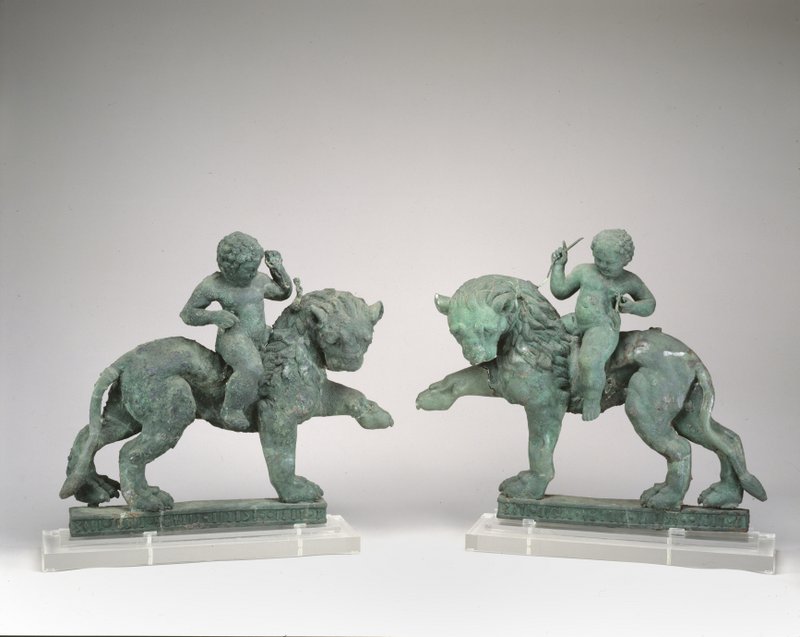 The “Lions of Timna”. Courtesy AFSM
The “Lions of Timna”. Courtesy AFSM
_______________________________
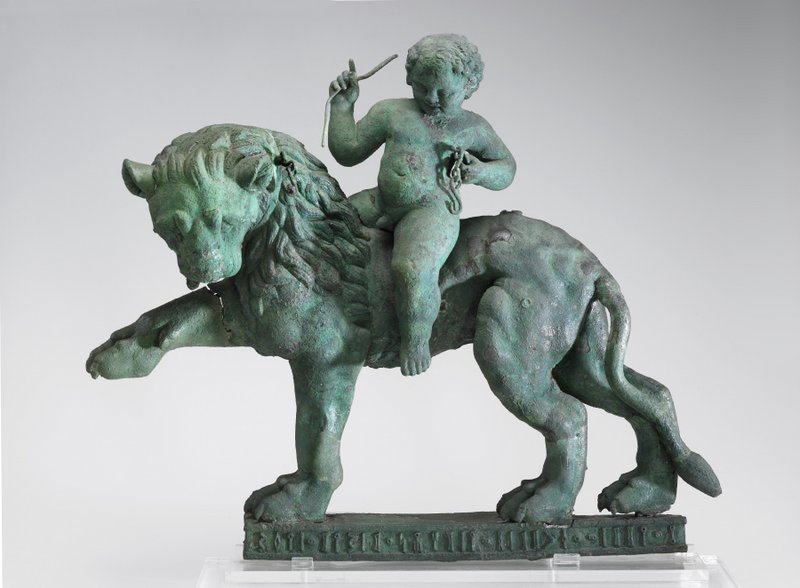 Detailed view of one of the twin “Lions of Timna”. Courtesy Sackler Gallery and AFSM
Detailed view of one of the twin “Lions of Timna”. Courtesy Sackler Gallery and AFSM
_______________________________
Hajar bin Humeid
To be sure, the southern Arabian expedition was much about adventure, but, like the great African expedition that preceded, it was first and foremost about systematic, scientific inquiry and investigation. Under the leadership of Professor and Chief Archaeologist William F. Albright, one of the expedition’s first tasks was to establish a base relative chronology from which to work for placing the hoped-for upcoming finds into context. That opportunity came with Hajar bin Humeid, where a large oval-shaped mound featured an eroded cross-section on its western side, affording the team an ideal starting point for determining stratigraphy and recovering pottery and layers of human occupation. “A rectangular cut about 60 feet square was made from the top downward,” recounts Phillips.* Excavations at Hajar continued for two seasons, from 1950 through 1951, exposing a stratigraphy that gave them a dating sequence based on eighteen strata, going back to the end of the 11th century BCE. “Hajar bin Humreid was full of surprises for Professor Albright and Dr. Albert Jamme, our Belgian epigrapher from Louvain, who expected to find broken pottery but instead encountered at the outset extensive stone walls of houses and a possible temple,” wrote Phillips*. But an abundance of pottery sherds and other artifacts, key to determining the dating sequence, invariably followed, and in great numbers. The artifacts, combined with the site’s ancient location, suggested that Hajar bin Humeid was located along one of the caravan routes that stretched all the way to the Mediterranean. It represented the remains of a modest-sized city that likely thrived primarily on customs collected from the caravans that traveled through the Wadi Beihan area.
_________________________________
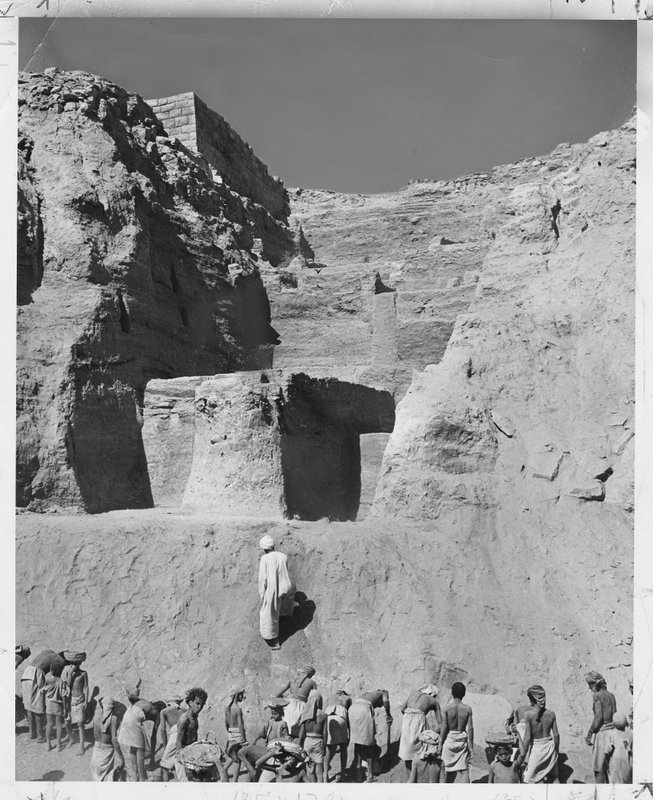 View of cross-section excavation of the mound at Hajar bin Humeid. Pottery finds helped to date the stratigraphy of the site back to at least 1,000 BCE. Courtesy AFSM
View of cross-section excavation of the mound at Hajar bin Humeid. Pottery finds helped to date the stratigraphy of the site back to at least 1,000 BCE. Courtesy AFSM
______________________________
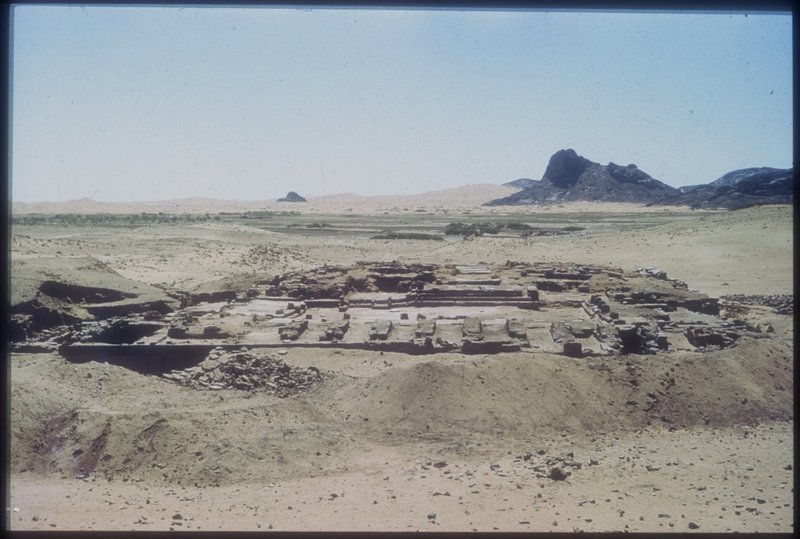 Panoramic view of the ancient site of Timna. Courtesy AFSM
Panoramic view of the ancient site of Timna. Courtesy AFSM
_______________________________
The South Gate
Chief among Phiilips’ goals was to uncover the remains of what was identified as Timna’s buried South Gate, entrance to the city itself. It was here that the monumental character of Timna really began to take shape. As at Hajar bin Humeid, a large team of workmen was employed to remove what seemed to be tons of sand, and after three weeks of excavation its features finally took shape:
The gateway itself was flanked by two massive towers constructed of rough blocks, some as large as 8 by 2 ft. The masonry work was good but not smoothly finished, indicating that the gate was built before the flowering of Qatabian civilization, when more polished work was done. Certainly it was made not later than the fifth century BC. Many inscriptions were found on the big blocks of the towers, and there was also evidence of two vertical grooves for gateposts and another for a heavy crossbeam. Charred wood still remained in parts of these grooves [evidence of a fiery conflagration].
Now we had our first glimpse, infinitesimal but still a glimpse, of ancient Timna. It was not too difficult to approach the massive South Gate and imagine ourselves part of a camel caravan loaded with frankincense, on our way from the lands of the East to the Mediterranean.*
— p. 85, Sheba’s Buried City
In addition to the structure itself, the team recovered artifacts interpreted as objects for religious ceremony and inscriptions with references to Qataban rulers. Their findings at the South Gate, like the findings at the Hajar bin Humeid cut, were instrumental in developing a chronology of Timna and its people, a chronology they found went back at least as far as the 8th century BCE.
_________________________________
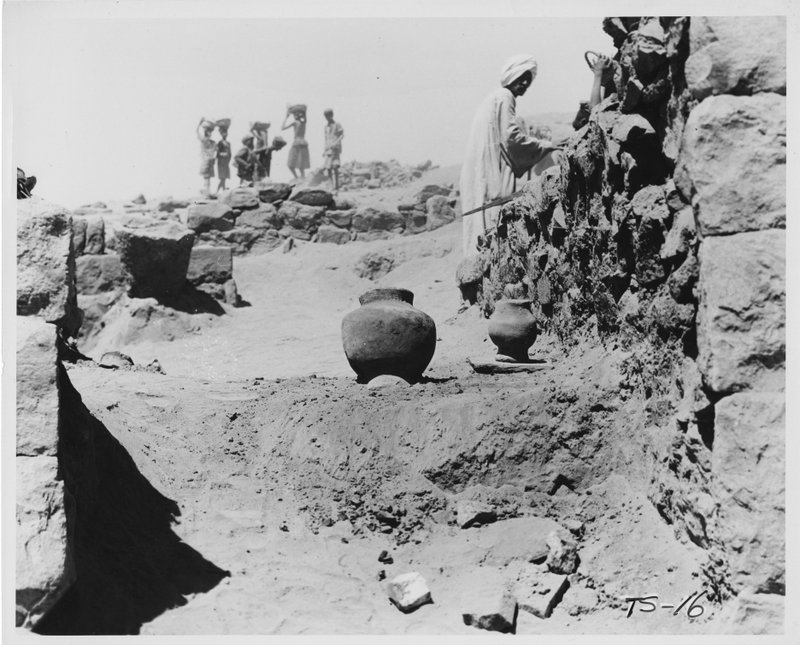 Excavations at the South Gate. Courtesy AFSM
Excavations at the South Gate. Courtesy AFSM
________________________________
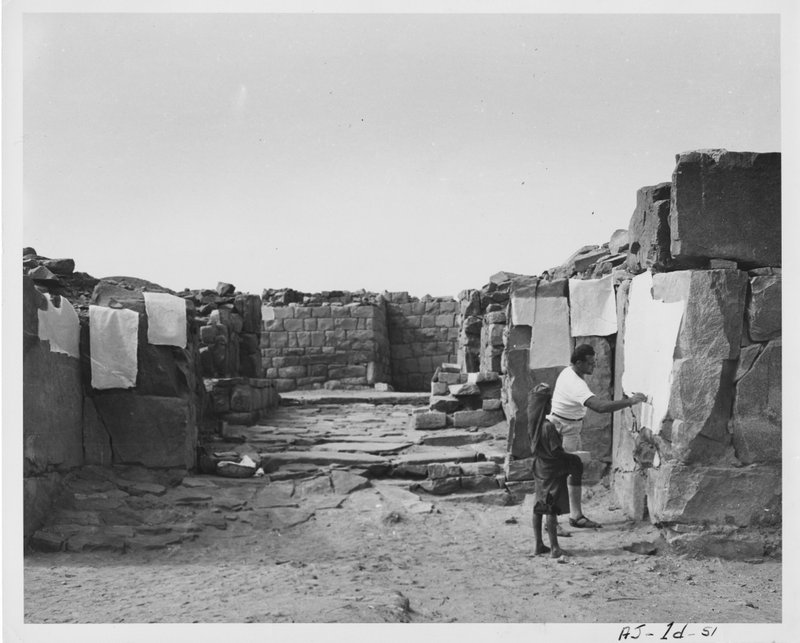 Dr. Jamme, the expedition epigrapher, creating latex squeezes of inscriptions found on the walls of the South Gate. Courtesy AFSM
Dr. Jamme, the expedition epigrapher, creating latex squeezes of inscriptions found on the walls of the South Gate. Courtesy AFSM
_______________________________
The Epigrapher’s Dream: The House Yafash and the Graffito Valley
As the excavators continued to progress beyond the gate into the city, they eventually came upon evidence of a structure. Designating it Building B, it featured inscriptions that identified it as the “House Yafash”. It was in the context of this ancient house that the expedition uncovered the twin bronze lions, arguably their most important find. Under the direction of Albright, the team found that three of the rooms within the structure were still intact. They also uncovered a number of utilitarian objects, including a burned comb, several containers, and a stone die, shedding light on ancient Qataban domestic life. But it was the subject, style, make, and inscriptions deciphered on the bronze statues that paved the way to understanding the timeline and culture of this southern Arabian kingdom. The lions and their riders were critical not only in establishing the chronology, but also in determining its greatest florescence in the first century CE.
_______________________________
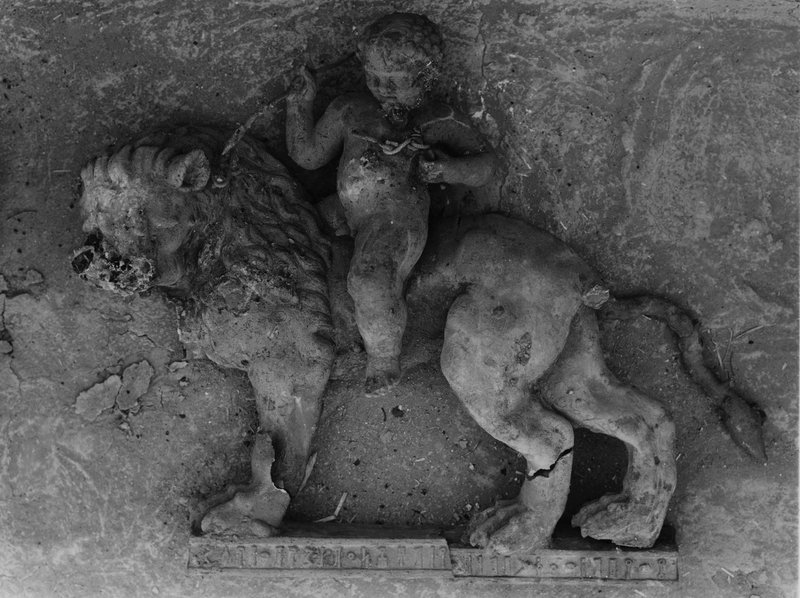 One of the “Lions of Timna” still ‘in situ’, as found in place immediately after excavation. Note the inscription at its base. Courtesy AFSM
One of the “Lions of Timna” still ‘in situ’, as found in place immediately after excavation. Note the inscription at its base. Courtesy AFSM
___________________________________________
Like literally hiking back through time, however, it was the result of a foray by a team colleague into a narrow canyon known as the Wadi al-Fara about three miles north of the Hajar bin Humeid that captured Phillip’s imagination in equal measure. Clued in and led by a local Beihani tribesman, team member Dr. Richard Bowen discovered what was surely to become one of the great discoveries of his life:
The Beihani tribesman led Bowen up a steep slope and then directed him to what turned out to be an ancient Qataban inscription carved into the rock face. But there was much more. Phillips recounts in his book:
Dick knew that the inscription might be interesting, but he was far more excited about other things he saw on the walls of the canyon—great numbers of graffiti, or shallow carvings in the rock surface. These graffiti contained short inscriptions with personal names: the equivalent of our ‘Kilroy was here’ scrawls on walls or carvings on trees. This is the plain, simple stuff of which real archaeological treasure often consists.*
With the able decipherment and interpretation from Jamme and Albright, what they had discovered was to this point the “earliest phase of Arabian inscription…..dating back probably to the 9th or 10th century BC,” containing three names found in the Bible—the father of Jeroboam, the first king of Israel, Eli, the name of a high priest mentioned in First Samuel, and Yagur, a place name in ancient Judah. “While our excavation work had slowly carried us backwards in time—to the destruction of Timna, and on to the first, second, third, and even fourth centuries BC,” wrote Phillips, “Graffito Valley whirled us past five or six more centuries and brought us close to the ancient days of the Bible, close to the time of the Queen of Sheba, who lived in Marib, just 40 miles away.”*
The House Yafash and Graffito Valley experiences were certainly not the only cases where inscription finds opened up a window on the world of the Qataban people to the team. Throughout the entire duration of the excavations, they encountered them. The inscription finds could arguably be considered the greatest takeaway from Phillips’ Arabian Expedition.
__________________________________
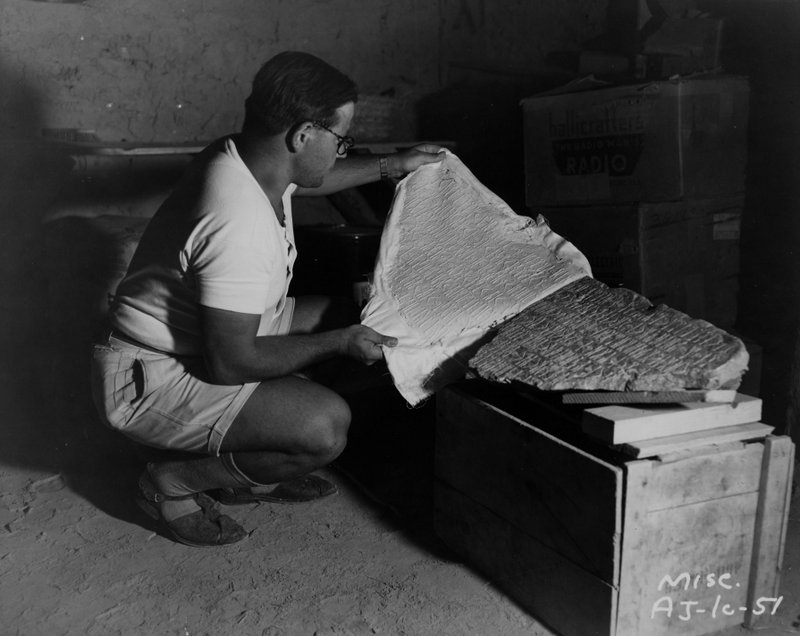 Dr. Jamme making a squeeze of one of the many inscription finds. Courtesy AFSM
Dr. Jamme making a squeeze of one of the many inscription finds. Courtesy AFSM
_________________________________
The Cemetery
It showed up first as a small white ring emerging from the sand and soil as a workman dug. It was part of a waxen human ear. Realizing the potential significance of this find, he called for Dr. Alexander Honeyman, an archaeologist and epigrapher and Professor of Hebrew and Oriental Languages at the University of St. Andrews. He was directing the excavations of the Timna Cemetery, an important part of the overall excavations at Timna. Few of the finds from the Cemetery excavations, however, caught Honeyman’s interest more than this one. After Honeyman’s careful excavation to reveal more of the find, it turned out to be a beautifully sculpted alabaster head of a woman with large eyes inlaid with a blue material, swept-back hair made of plaster, pierced ears that likely once held earings, and holes in the sides of the neck that likely were meant to secure a necklace. It could be held in one’s hands. Nicknamed “Miriam” by the Arab workmen, it was dated to the 1st century BCE and the first half of the 1st century CE. Although there were no inscriptions to help identify the woman’s actual identity, Honeyman and his colleagues concluded that, given the workmanship, material and other features, this was probably a woman of means and importance.
_________________________________
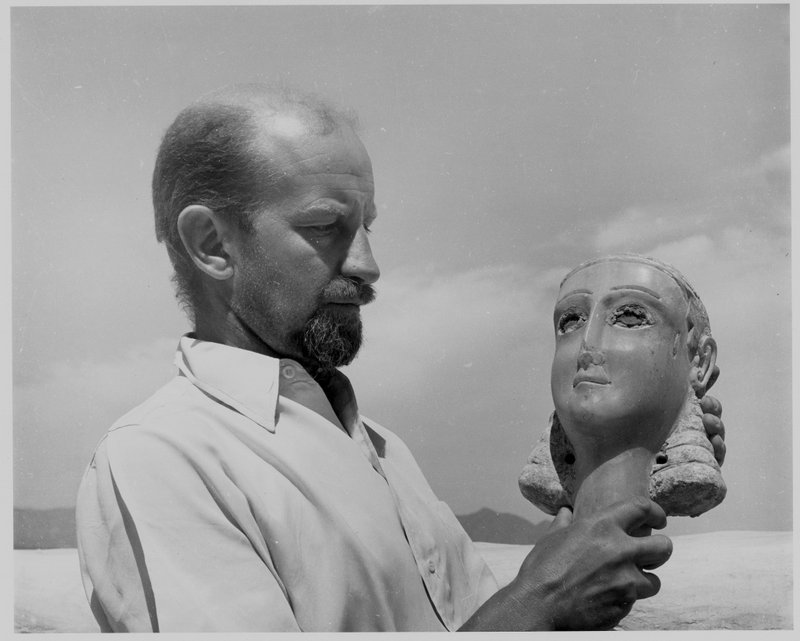 Dr. Honeyman holding “Miriam”, his prize find. Courtesy AFSM
Dr. Honeyman holding “Miriam”, his prize find. Courtesy AFSM
_______________________________
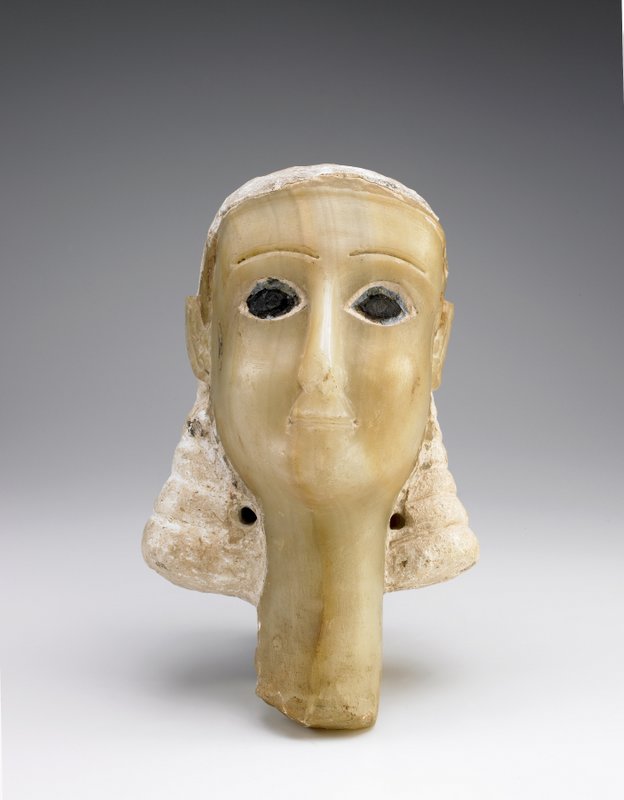 Detailed view of the head of a woman, or “Miriam”. Courtesy Sackler Gallery and AFSM
Detailed view of the head of a woman, or “Miriam”. Courtesy Sackler Gallery and AFSM
________________________________
This was clearly a sign of more things to come, for it was only a day later that they recovered an exquisitely crafted gold necklace, pendant and chain combination, with a legend in Qataban letters identifying the owner of the piece, a woman named Far’iat. Excavations at the Timna Cemetery proved to be one of the great achievements of the expedition, resulting in the discovery of mortuary buildings, steles and funerary portraits, along with a variety of miniature objects intended for the afterlife, in addition to Honeyman’s finding that a series of partitioned rectangular chambers within the mausoleum complex were actually ossuaries where bones of the deceased were re-interred. Today it is considered among the largest and most elaborate ancient necropolises in southern Arabia, a testament to the importance that the ancient Qatabans accorded their deceased.
________________________________
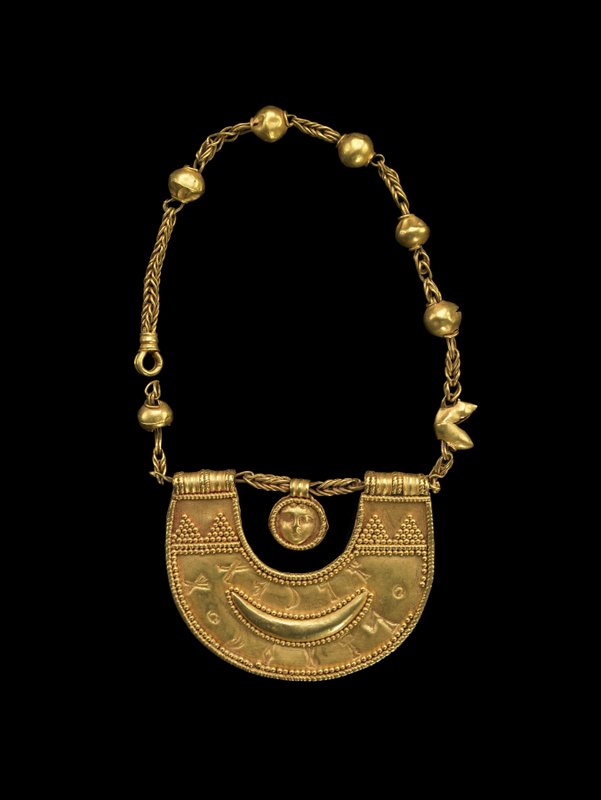 The gold necklace, pendant and chain combination discovered in the Cemetery excavations. Courtesy Sackler Gallery and AFSM
The gold necklace, pendant and chain combination discovered in the Cemetery excavations. Courtesy Sackler Gallery and AFSM
________________________________
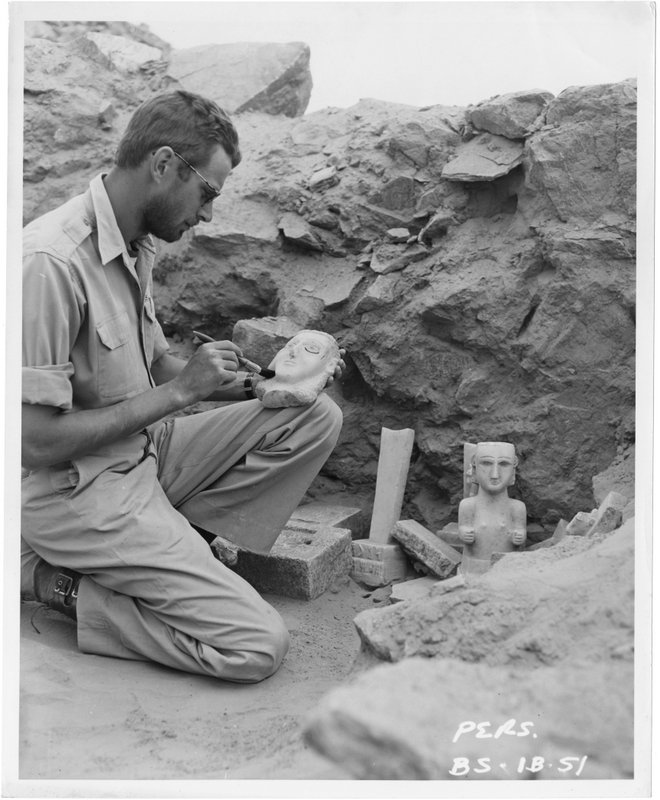 Above and below: Excavations in the Cemetery yielded numerous small funerary finds. Courtesy AFSM
Above and below: Excavations in the Cemetery yielded numerous small funerary finds. Courtesy AFSM
_______________________________
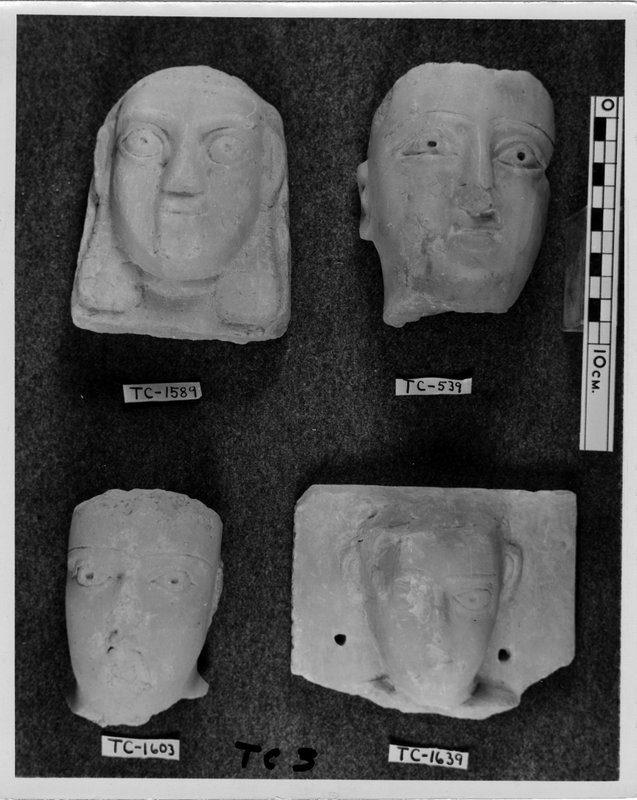 __________________________________________
__________________________________________
The Temple Complex
In terms of sheer magnitude, nothing more monumental was unearthed at the Timna site than the imposing structure of what Phillips’ team identified as a temple complex:
We had not worked long at the temple site that second season before confirming our view that here lay the largest building of ancient Timna. It was certainly the first really monumental building to be excavated in all South Arabia, for we dug in an area 160 ft. long by 135 ft wide without yet reaching the end of what was a complex of buildings and courts making up the Temple of Athtar, the Arabian equivalent of our Venus…….The Temple must have been a beautiful and imposing structure [in its day], for we found a central nave and foundations for four or five rows of gigantic pillars, with five pillars to a row. What an awe-inspiring spectacle this great Temple of Venus must have been to the weary traveler from Shabwa or farther east as he gazed upward through its forty to fifty columns!*
Built of massive blocks of stone, the complex consisted of the temple structure, an open court, rooms on its western side, and what they identified as a water tank. Excavations revealed that it had undergone four phases or periods of construction ranging from the 8th or 7th century BCE to the 1st century CE. It apparently stood until the final destruction of Timna, for the excavators encountered large blocks of stone that had been fused together—something that could happen only in a state of intense heat. Here was evidence of a fiery conflagration that likely caused the demise of a city that had existed for centuries.
Another major discovery came in 1951, when Albright observed ancient masons’ marks on marble paving stones in the Temple courtyard while guiding a visitor through the site. He could see that the stones had been tagged or marked using the sequence of letters or symbols of the South Arabian alphabet. For the expedition team, it was like looking at the Rosetta Stone for understanding the order of the ancient South Arabian alphabet. “This was a discovery of the first importance,” wrote Phillips. “The ancient Qatabians who had paved this court inscribed their alphabet around it. We had never known before the proper order of the ancient South Semitic alphabet, but now it had been discovered.”* This finding proved to be among the expedition’s greatest discoveries.
___________________________________
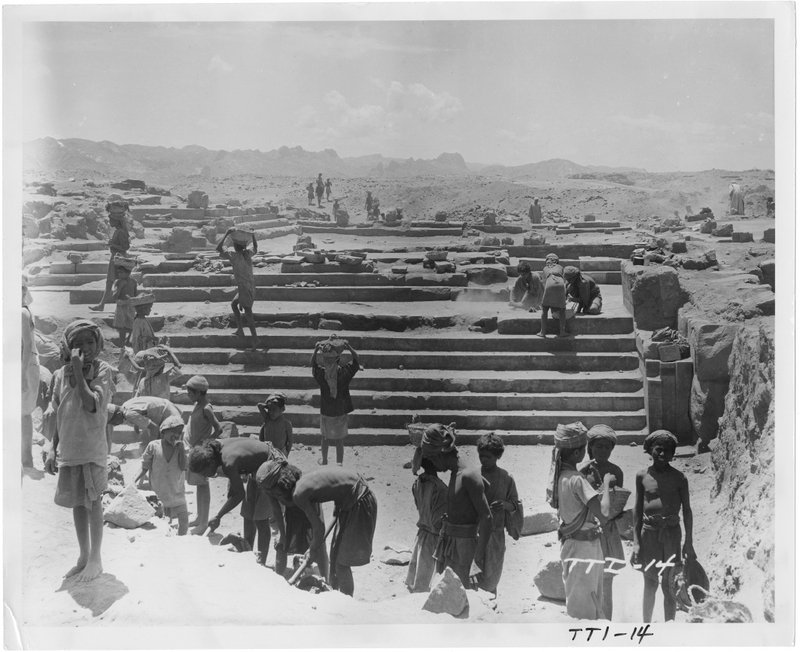 Above and below: Excavation at the Temple in Timna. Courtesy AFSM
Above and below: Excavation at the Temple in Timna. Courtesy AFSM
____________________________________________
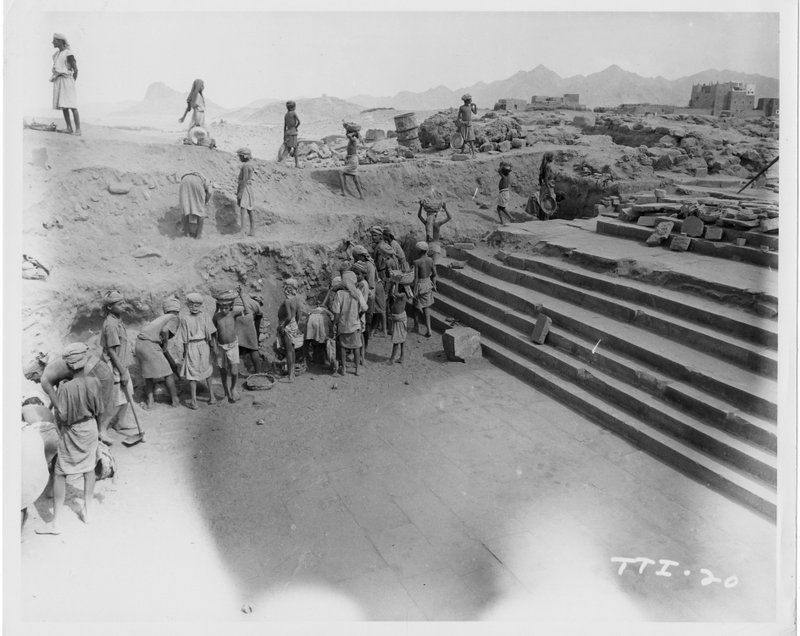 ________________________________________
________________________________________
The City of Sheba
No other ancient site in Yemen excited Phillips more than the prospect of excavating at Marib, the capital of the ancient Sabaeans and thought by many biblical scholars as the likely residence of the famed 10th century Queen of Sheba. It was among his plans from the beginning to explore the possibility of obtaining permission to excavate at the site, but the area was regarded as forbidden to Westerners because of tribal unrest. Approval and support from Imam Ahmed, the King of Yemen, however, could make all the difference, and this is exactly what Phillips attempted to obtain. An audience with the King was finally realized, resulting in approval for Phillips and his team to push forward to Marib for this, the first excavation by a Western expedition to Marib in over 60 years.
Getting to Marib required an uneasy journey northward across the dunes through what for Westerners was largely unexplored land. But once there, Phillips was overwhelmed by the site:
We were standing where no American or Englishman had ever stood and where no non-Moslem has been, to our knowledge, since 1889. We looked at the buried ruins of what had once been the largest and richest of the ancient cities of South Arabia, the centre of a great culture almost 3,000 years ago………Columns, walls and pillars extended everywhere as far as our eyes could see, in an endless crescent.*
Phillips knew that local Yemenis had already dug about 70 feet down at one point at the site to recover stone blocks for a fortress and houses, encountering cultural layers as they went. Compared to the 51-foot escarpment Phillips and his team created at Hajar bin Humeid, this suggested that “Marib was considerably older than the Qatabian cities in Beihan.”* This, Phillips hoped, would be the prize dig of the expedition. But he knew that excavating the entire city would be far too much to tackle at this point, so the team focused their efforts on what was clearly the most prominently visible feature of the city—the Mahram Bilqis, or Temple of Awam, otherwise known by the ancients as the Temple of Almaqah, dedicated to the moon god who was the principal deity of Marib.
Only the tops of eight massive pillars and the upper part of an oval-shaped wall could be seen jutting above the windblown sand at first, but as they dug, painstakingly removing tons of sand and soil with a workforce of scores of workmen, they eventually uncovered a large hall with monumental pillars, and stairways, inscriptions, and bronze and alabaster sculptures. In some places the wall of the temple itself, 13.5 feet thick and constructed of fitted ashlar masonry, still stood to a height of more than 27 feet above the temple’s excavated entrance hall. Adjacent to the temple they uncovered evidence of a mausoleum and tombs similar to what they had unearthed at Timna.
________________________________
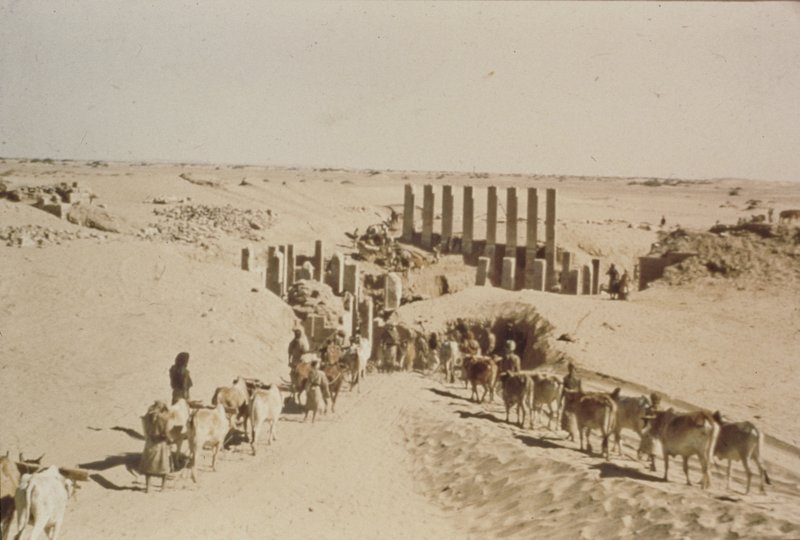 Excavations beginning at the Awam Temple in Marib in 1951. Courtesy AFSM
Excavations beginning at the Awam Temple in Marib in 1951. Courtesy AFSM
_______________________________
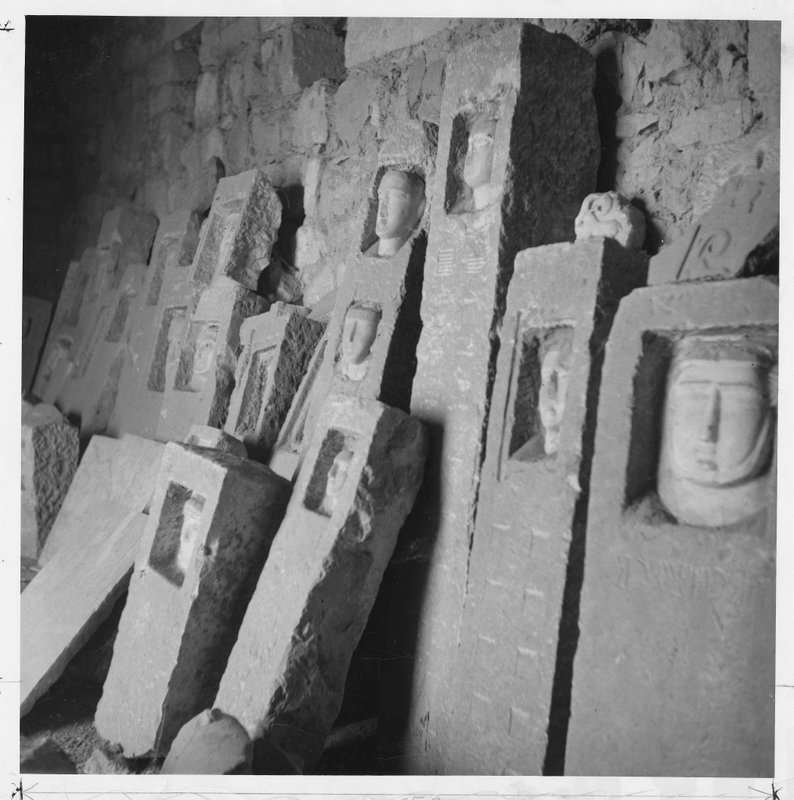 Above: Unearthed by Yemeni locals (long before the excavations) as they dug for building stones, these ancient alabaster sculptures (600 in all) were stored inside the old fortress at Marib. They were shown to the expedition team on a guided tour before excavations began. Courtesy AFSM
Above: Unearthed by Yemeni locals (long before the excavations) as they dug for building stones, these ancient alabaster sculptures (600 in all) were stored inside the old fortress at Marib. They were shown to the expedition team on a guided tour before excavations began. Courtesy AFSM
_______________________________
These discoveries were already magnificent by any measure, and there was potentially much more to unearth. But developing tribal tensions spelled danger for the team long before they could achieve their objectives, and they were forced to leave the site, never to return as an expedition under Phillips’ direction again. Their sudden, hasty exit meant leaving their equipment and archaeological discoveries behind, though their written records were later published in scholarly reports. Phillips died in 1975, never having realized his hopes of returning to Marib to finish the work.
Return to Marib
It wasn’t until 1998, more than two decades later, when renewed excavations began at Marib. Invited by the government of Yemen to resume excavations where her brother left off in 1952, Merilyn Phillips Hodgson, by then President of the AFSM, took the ball and ran with it. With more than fifty workmen and an international team that included archaeologists, epigraphists, architects, and other specialists involved in what turned out to be a multi-year expedition lasting nine seasons, their discoveries were no less sensational than those made decades earlier. Focusing on the Awam Temple, hundreds of new inscriptions were recovered, and for the first time, the interior of the oval precinct walls of the complex was uncovered to a depth of sixteen feet. Features of its main Peristyle Hall and Annex areas were uncovered and defined, and more insight to the construction and occupational chronology or sequence for the Temple was acquired.
“The earliest material cultural remains excavated in the Awam complex date to the eighth century BC,” wrote archaeologists Zaydoon Zaid and Mohammed Maraqten in a report of their findings from the Temple complex. “Inscriptions mark the beginning of the history of occupation of the site.” Added to this, “a recently discovered but as yet unpublished inscribed block that served as the base of a statue mentions a dedication by the Shab of Saba and is dated according to the Himyaritic era (i.e. 115 or 110 BC) to the late fourth century AD. It confirms the continuity of the main function of the temple as a sacred place……..The architectural sequence for the Awam temple would therefore seem to span a period from the first millennium BC to the late fourth century AD.”**
________________________________________
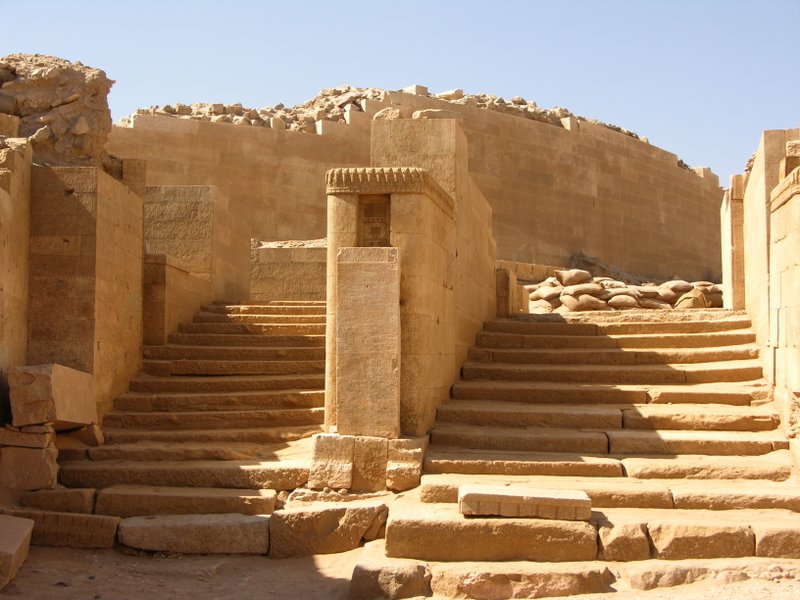 Above: View of the impressive excavated staircase in ‘Area A’ of the Awam Temple. Excavations have revealed that the Temple Complex includes several major architectural components: The Oval Wall, enclosing most of an open-air Oval Precinct; The Peristyle Hall with thirty-two pillars surrounding a large courtyard; The Annex Area along the north-east side of the Peristyle Hall and parallel to the eight monumental pillars; A large courtyard area, Area A, building 1, paved passage and staircases; A mausoleum adjacent to the south-east exterior of the Oval Wall; and a cemetery to the south-west of the Oval Wall. Courtesy Zaydoon Zaid and the AFSM
Above: View of the impressive excavated staircase in ‘Area A’ of the Awam Temple. Excavations have revealed that the Temple Complex includes several major architectural components: The Oval Wall, enclosing most of an open-air Oval Precinct; The Peristyle Hall with thirty-two pillars surrounding a large courtyard; The Annex Area along the north-east side of the Peristyle Hall and parallel to the eight monumental pillars; A large courtyard area, Area A, building 1, paved passage and staircases; A mausoleum adjacent to the south-east exterior of the Oval Wall; and a cemetery to the south-west of the Oval Wall. Courtesy Zaydoon Zaid and the AFSM
___________________________________
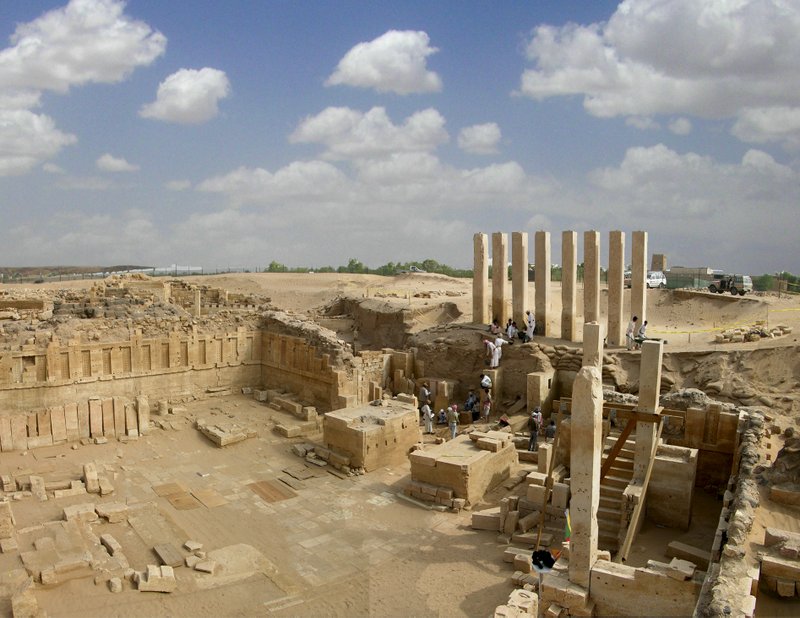 View of the excavated Peristyle Hall and Annex area. Courtesy Zaydoon Zaid and the AFSM
View of the excavated Peristyle Hall and Annex area. Courtesy Zaydoon Zaid and the AFSM
___________________________________
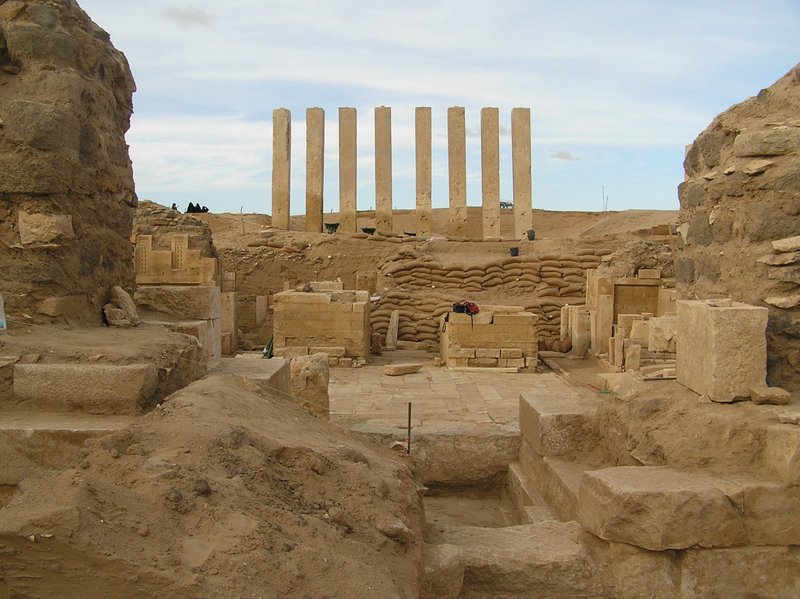 The Temple pillars as seen from inside the Oval Wall. Courtesy Zaydoon Zaid and the AFSM
The Temple pillars as seen from inside the Oval Wall. Courtesy Zaydoon Zaid and the AFSM
_________________________________
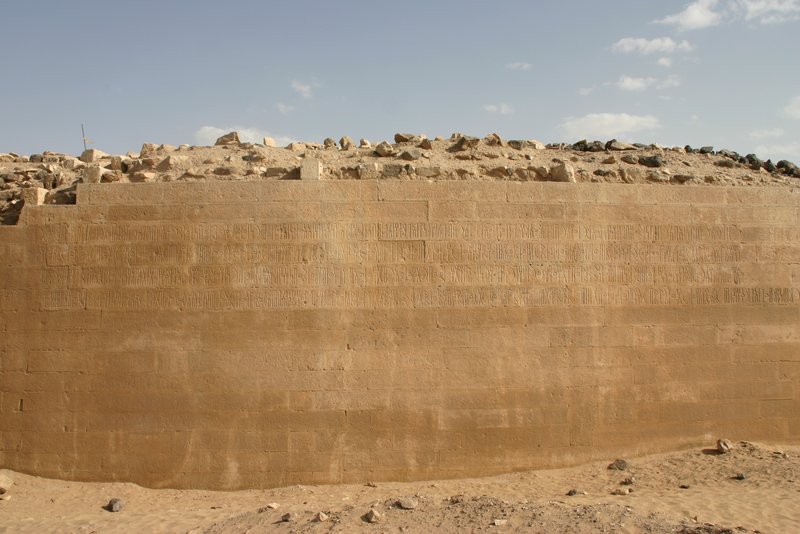 The monumental wall that surrounds the Oval Precinct of the temple complex. Note the inscriptions on the upper rows of blocks. Courtesy Zaydoon Zaid and the AFSM
The monumental wall that surrounds the Oval Precinct of the temple complex. Note the inscriptions on the upper rows of blocks. Courtesy Zaydoon Zaid and the AFSM
_________________________________
The results of the renewed excavations further confirmed what Phillips had, decades before, concluded about the significance of the site. In terms of the construction date chronology, continuity of use, opulence and monumental scale, the Awam Temple was, according to Zaid, clearly “one of the most important monuments of the Sabaean period, which doubtless composed the religious center of the city of Marib and of ancient South Arabia as a whole”.** It bespoke a civilization that, in its time, rivaled the great civilizations to its north, west and east, for it was in Marib that the Sabaean kings made their capital, building massive irrigation works such as the Ma’rib dams, (the ruins of which are still visible) and other monumental buildings, made possible by the wealth brought in through the incense trade routes and extensive maritime connections as a seafaring people. It was a flourishing culture for more than a thousand years.
Was it here, at the Awam Temple, that the biblical Queen of Sheba worshipped? As far as scholars know, the temple construction chronology post-dates the time period in which many biblical scholars suggest she lived, the 10th century BCE. Was there an earlier temple on this spot? Further excavation may shed additional light on the question. “One of our main objectives is to continue excavating inside the Oval areal, where we think we will find a lot of answers that will help to establish and complete the occupational history of the site,” says Zaid.
Zaid hopes to one day return to finish where the last set of seasons left off nine years ago, but the political situation and unrest mitigates the possibilities.
He tempers some sadness with wishful anticipation. “Yemen is a unique land, something like an open museum,” he says. “When you travel in Yemen, talk to the kind Yemeni people, visit the old cities and the amazing bazaars—you would think that time has stopped. Things are still much the same as they were hundreds of years ago. We hope that the situation in Yemen will develop in a positive way, so that the people of Yemen will have their peace and go back to normal life and, of course, allow us to go back to continue our work at the temple.”
Phillips, no doubt, if he were alive, would be in the front of the pack.
___________________________________________
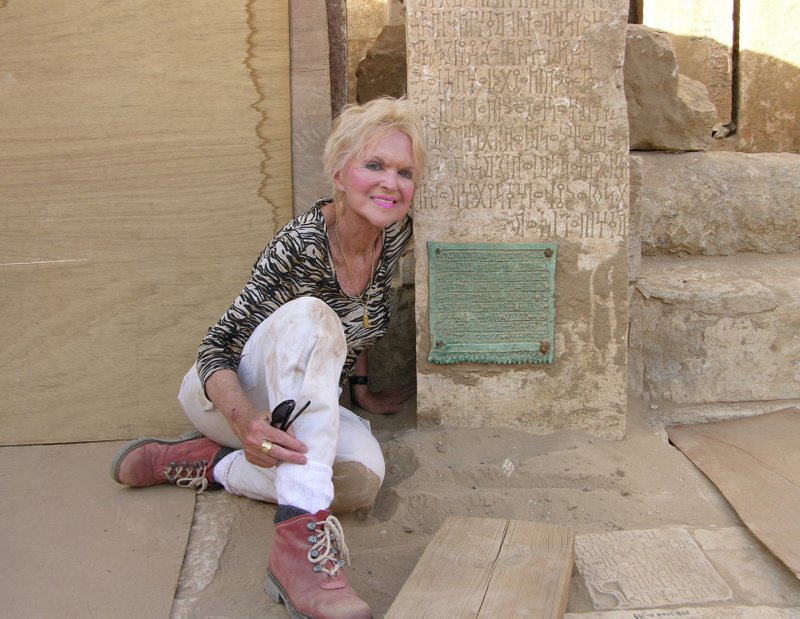 Merilyn Phillips Hodgson, current President of the American Foundation for the Study of Man and sister of Wendell Phillips. Courtesy the AFSM
Merilyn Phillips Hodgson, current President of the American Foundation for the Study of Man and sister of Wendell Phillips. Courtesy the AFSM
___________________________________________
* Phillips, Wendell, Sheba’s Buried City, 1958 Pan Books Ltd.
** Zaid, Zaydoon and Maraqten, Mohammed, The Peristyle Hall: remarks on the history of construction based on recent archaeological and epigraphic evidence of the AFSM expedition to the Awam temple in Marib, Yemen, Proceedings of the Seminar for Arabian Studies, Vol. 38, 2008
___________________________________________
Receive 30 days free access to the popular new CuriosityStream lineup of documentaries on science, history, nature, and technology as a new Popular Archaeology premium subscriber.
___________________________________________
Travel and learn with Far Horizons.
____________________________________________
This richly illustrated issue includes the following stories: Recent findings shedding new light on the whereabouts of the remains of Philip of Macedon, father of Alexander the Great; how an archaeologist-sculptor is bringing bones of the dead back to life; archaeologists uncovering town life at the dawn of civilization; an exclusive interview with internationally acclaimed archaeologist James M. Adovasio about what makes the Meadowcroft Rockshelter prominent in the ongoing search for the first Americans; what archaeologists are finding at the site of the ancient city of Gath, the home town of the biblical Philistine giant, Goliath; and how scientists are redrawing the picture of human evolution in Europe. Find it on Amazon.com.

